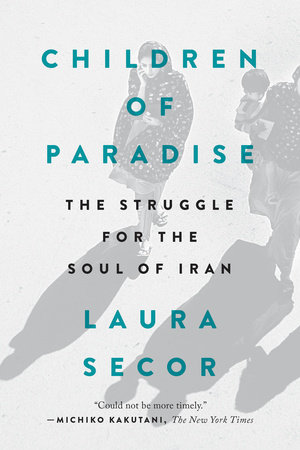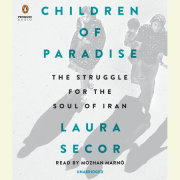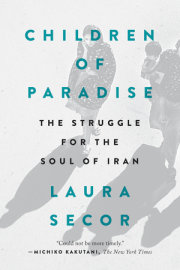one
Little Black Fish
On a cold winter night, at the bottom of the sea, a wise old fish gathered twelve thousand of her children and grandchildren and told them a story.
Once upon a time, she began, a little black fish lived in a mountain stream with its mother. From dawn until dusk, mother and child swam in circles, in and out of crevices, following each other until night fell and they went to sleep in their home under a mossy rock.
One morning before sunrise, the little fish woke its mother and announced that it was leaving. A single thought had come to possess its mind: Where, the little black fish wanted to know, did the stream end?
The mother laughed. "My dear," she said, "a stream has no beginning and no end. That's the way it is. The stream just flows and never goes anywhere."
The little black fish was certain that this could not be true. Despite threats from its elders, and to the awe of its peers, off it went, down the waterfall and into a pond, where the only creatures in sight were tadpoles.
The tadpoles told the little black fish that they came from nobility and that they were the most beautiful creatures in the world. The world, they said with confidence, was the pond where they swam. Their mother, a frog, chided the black fish, calling it a "worthless creature" for leading her young astray.
Undaunted, the little black fish swam on, outwitting predators and overcoming many obstacles on its way to the open sea.
There the fish found a school of brave, indomitable fish like itself. So powerful was this school of fish that it foiled fishermen by dragging their nets to the bottom of the sea.
At last the little black fish had found its true place in the world. Before joining its brethren, it went for a swim along the water's surface, where it could feel the sun on its back. The fish knew that it was vulnerable to predators there, but by now it also understood that its own mortality was a trifle. "What does matter," the fish told itself, "is the influence that my life or death will have on the lives of others."
Just then, a heron swooped and swallowed the fish. Inside the heron's stomach, the little black fish heard someone crying. It was another fish, tiny and young, who missed his mother. The little black fish thought quickly. It would swim around to tickle the heron's stomach, the black fish told its tiny companion. When the heron laughed, the tiny fish should leap out of her mouth. The little black fish would stay behind and kill the heron with a dagger made from a blade of grass.
And so the little black fish tickled, and so the tiny fish leapt. From the safety of the water, the tiny fish watched the heron writhe and shout, beating her wings as she fell to her death. But the little black fish never emerged.
The grandmother fish had finished her story. She and eleven thousand nine hundred and ninety-nine of her spawn went off to sleep. One little red fish lay awake. She could not stop thinking about the sea.
So goes the childrenÕs story that inspired a generation of Iranian revolutionaries. The Little Black Fish, by Samad Behrangi, was published in 1968, the year its twenty-nine-year-old author spent a hot week at the end of August touring villages near the Aras River in the north of Iran. He was collecting folklore with a friend, something he had done often in the remote rural villages of his homeland. One day he waded by the shore of the river to cool himself while his friend swam. The young writer was not aware of it, but the Aras was known locally for its fierce current, which easily lashed him from the spot where he stood. Behrangi could not swim. He cried out, but by the time his friend reached him, he had vanished into the riverÕs depths. The author of The Little Black Fish drowned, his body pulled five kilometers downstream, where it was found three days later.
Behrangi had spent a decade traveling to poor villages, distributing books he'd purchased himself to needy children. He was not a religious man but a man of the left, moved by the depth of rural poverty. He noticed something on these trips: Iran was not only an unequal country, but a country alienated from itself. Iranian elites were steeped in the ideas, the culture, the mores of Europe and America. But the country's interior was nothing like those places.
Iranian teacher-training texts, Behrangi noted in an early essay, came overwhelmingly from America, and they focused on concerns, including childhood obesity and school lunch programs, that were laughably inapplicable to Iranian village life. When Iranian children were taught English-a language Behrangi also studied-their textbooks referenced hot dogs and baseball, cultural markers that were meaningless to the children of rural Iran. Iranian teachers ought to focus on the pressing needs and cultural realities of Iranian children, to come up with their own pedagogy to fit their real context.
Behrangi wrote short stories in the form of folktales in order to avoid censorship, but within them he embedded revolutionary exhortations, even to the violent overthrow of the ruling class with its American affectations. If The Little Black Fish strikes today's Western reader as dark for a children's book, that was not Behrangi's concern. "I don't desire that aware children read my stories only for pleasure," he wrote. "We must lead our children away from building hopes on false and empty visions, toward creating hopes based on a correct understanding and interpretation of the harsh realities of society and on how to struggle to eliminate those harsh realities."
Eleven years after his death, when Behrangi's countrymen dragged the fisherman's net to the floor of the open sea, many of them cited his story as their inspiration. It was a parable of courage and sacrifice, and of the refusal to be blinded by convention or confined by fate. At the time of Behrangi's writing, in 1968, Iran seemed, to some, like a plebeian mountain stream that just flowed and never went anywhere; to others, like a haughty, noble frog pond that did not even know the stream that fed it. The germ of revolution was to refuse to be bounded by the accidents of birth, the fear of predators, or the riverbanks of fate.
Nobody asks anymore why Iran had a revolution in 1979. Western powers had robbed Iran of its resources and made puppets of its leaders. Iranians suffered political repression and glaring inequality. IranÕs religious leaders and its merchant class saw the culture and economy they held dear slipping away, displaced by arrangements suitable to foreigners. With all we now know, the Islamic Revolution of 1979 seems overdetermined. But what we forget, or underestimate, or maybe never knew, is that the Iranian Revolution was not a simple act of refusal-of modernity; of the West; even, in the end, of absolute rule. It emerged in impassioned, ambivalent dialogue among passionate, ambivalent people. And the state it produced is passionately ambivalent, too.
Outside Iran, we have come to associate the Islamic Revolution with the severe, otherworldly face of Ayatollah Ruhollah Khomeini and the return of theocracy in the twentieth century. Behind and within this story is another history-of a revolutionary impulse as complexly modern as the society that produced it, and which has yielded a culture of civic engagement as imperishable as the quest of the little red fish. To the extent that the postrevolutionary state has tried to deny the multiplicity of its origins and to suppress the engagement of its people, its course has followed an arc of tragedy.
The story of Iran's Islamic Revolution and the republic it spawned is not only-perhaps not even primarily-a story about religion. It is a story about politics and identity, about social division and cohesion, about the forces that move history everywhere in the world. It is also the story of individuals who have quested ceaselessly, pressing against seemingly impermeable barriers, for the open sea.
Iranian revolutionaries sometimes describe their revolution, in terms resonant with Behrangi, as the convergence of many streams of thought and activism. Some of these streams were religious. Others were secular. Where the basin widened, the religious and secular ideas became, if not indistinguishable, inextricable. That did not occur right away. But when it did, history happened, and has been happening ever since.
To make a myth of Samad Behrangi's eerily resonant death by drowning was nearly irresistible. The man who did so was Behrangi's friend and champion in Tehran's intellectual circles, Jalal Al-e Ahmad, an essayist active against Iran's autocratic king, Shah Mohammad Reza Pahlavi. Al-e Ahmad had hosted Behrangi at his Tehran salon, and he wrote affectionately about the teacher, storyteller, and folklorist he called his younger brother. It was Al-e Ahmad who floated the legend that Behrangi was murdered by the shah's secret police, even persuading the friend who was with Behrangi the day he drowned to keep quiet about the details of the accident.
That fall Al-e Ahmad wrote in an essay, "Now we must mourn in our agony for this younger brother and eulogize him? And anyway, how many Samads do we have? . . . No, it's no good. Now it's better if I . . . instead of mourning this younger brother's death or carrying a cane, start a rumor that Samad, just like that Little Black Fish, has made his way through [the] Aras to the sea so that he may reappear one day."
With Behrangi, Jalal Al-e Ahmad was one of the most important fish in the secular stream. His most famous work was an extended essay called Westoxication, published underground in 1962. Westoxication excoriated Iranians for what Al-e Ahmad saw as their self-loathing worship of the West. This plague ate away at Iranian industry, culture, power, and self-esteem. The machine, invented in the West and controlled by the West, was devastating Iranian pastoral life. The old arrangements, economic and social, had been upended, but the new ones, devised elsewhere and evolved to suit an alien history and culture, made no sense for Iran's largely rural people. There was no use trying to rewind modernity; the only hope was for Iranians to seize control of the machine themselves, to bring it to their villagers not as a replacement for their labor but as a tool for their betterment.
Westoxication would become the foundational text of revolutionary Iran's anti-Americanism. But it was a cry less of hatred than of anguish. That Iran had borrowed too heavily from the West, that it had adopted an alien intellectual tradition that lacked roots in local culture or history-that Iranians consequently saw themselves as inferior to Westerners, and saw themselves through the eyes of Westerners who looked down on them-was a nearly inevitable critique at that time. But Western influence on Iranian philosophical thought was too deep to cast off completely, its attraction too profound. Iran was enmeshed as though in a relationship with an abusive lover, self-loathing bound up with the contempt in which it was held. For the very fact of loving its abuser, Iran hated itself.
The solution to this problem was not obvious. The Western intellectual tradition was intertwined with the Persian one from its root. The Shiite seminaries of Najaf and Qom taught the same ancient Greek philosophy that lay at the foundation of European thought. Generations of Iranian students abroad soaked up European ideas and brought them home. Iranian thinkers had built on, around, and against these schools of European thought. Al-e Ahmad himself ended his anti-Western manifesto by appealing to the works of Albert Camus, Eugene Ionesco, and Ingmar Bergman. Was there really any such thing as a separable Western tradition? If so, was it something alien, adapted from and to foreign cultures and different circumstances, or was it, even so, as much an Iranian birthright as a French or German or American one? The Iranian thinkers of the 1960s embodied this dilemma. In their effort to create a native, Iranian intellectual language and political ideology, they drew on Western sources, because those sources were as natural to them as the native ones-as available, as meaningful, as useful.
Jalal Al-e Ahmad died in 1969. And when he did, perhaps the most influential thinker of all stood ready to carry the revolutionary relay to its finish. Ali Shariati would fashion an ideology that was the stuff of a generation's dreams: militant, transcendent, and inalienably, authentically, Iranian.
Shariati, a charismatic orator and Islamist ideologue in the eastern shrine city of Mashhad, had met Al-e Ahmad earlier that year. Younger, wilder, more imaginative-already holding sway over rooms of students who sat, hypnotized, well after the bell that marked the end of class-Shariati must have known at some level that the light Al-e Ahmad carried would soon pass into his own hands. When the author of Westoxication died, Shariati wrote, ÒI completely forgot all the memories, ties, friendship, intimacy and harmony that existed between me and dear Jalal. His face faded away in my memory and instead another loomed. It was my own face! It was as if I had heard the news of my own death.Ó
Shariati called for casting off what he saw as the courtly, superstitious, passive Islam of the clergy and reviving what he considered the true Islam-one that was militant and justice-seeking, and which contained the answers to nearly all of man's problems. He married the language and concerns of Iran's secular opposition to the identity of its Shiite masses. He might as well have split the atom.
Shariati's charisma was legendary. He habitually arrived late to his lectures, smoked while he spoke, and held forth for as many as six hours at a stretch. But the oratory was so powerful that one of his students told his biographer, "During his lectures, you would be so carried away with his performance that you wouldn't even feel the chair you were sitting on." Even some of his bitterest critics, today, wax sentimental at the mention of his name. As it turned out, he was a dangerous man, they say. But oh, you should only have heard his voice.
Shariati was born in 1933 to a traditional lower-middle-class family in a northeastern desert town not far from the Turkmen border. His father was a local religious teacher who founded an important Islamic center in the city of Mashhad. In many ways Shariati's thinking would follow a clear line from his father's. Shariati's father spoke of shaking off superstition and passivity to make religion into a more active force in Iranian life. He modeled for Ali the study of Western ideas as well as Islamic ones: the capacity to swim in two streams, one traditional and religious, the other modern and rationalistic, in order to speak a single language to a divided society-perhaps even to his divided self.
Copyright © 2017 by Laura Secor. All rights reserved. No part of this excerpt may be reproduced or reprinted without permission in writing from the publisher.





